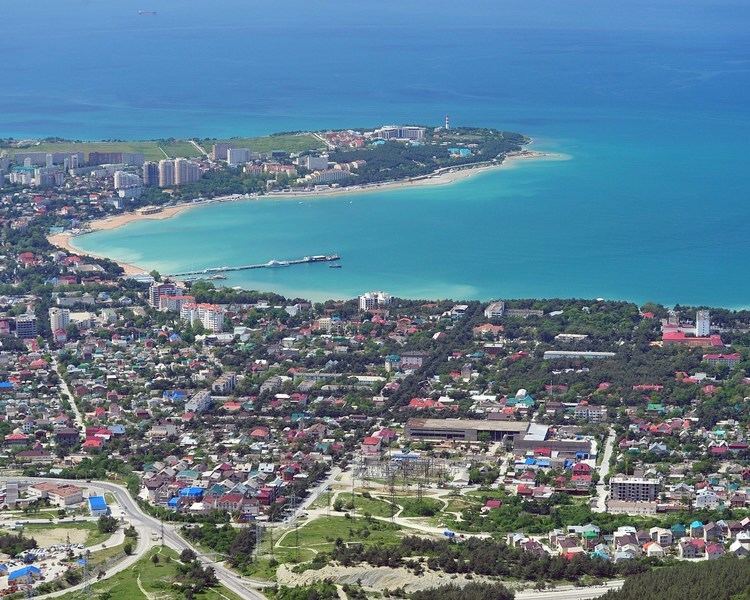Coat of arms Flag Administrative center of Town of Gelendzhik Local time Saturday 5:04 PM | Administratively subordinated to Town of Gelendzhik Urban okrug Gelendzhik Urban Okrug Number of airports 1 | |
 | ||
Weather 16°C, Wind NE at 18 km/h, 51% Humidity Points of interest Zolotaya bukhta, Delfin, Gelendzhik Dolphinarium, Aquapark Begemot, Gelendzhik Local History M | ||
Gelendzhik (Russian: Геленджи́к) is a resort town in Krasnodar Krai, Russia, located on the Gelendzhik Bay of the Black Sea, between Novorossiysk (31 kilometers (19 mi) to the northwest) and Tuapse (93 kilometers (58 mi) to the southeast). Greater Gelendzhik sprawls for 102 kilometers (63 mi) along the coastline and covers an area of 122,754 hectares (303,330 acres), although only 1,926 hectares (4,760 acres) fall within the boundaries of Gelendzhik proper. Population: 54,980 (2010 Census); 50,012 (2002 Census); 47,711 (1989 Census).
Contents
- Map of Gelendzhik Krasnodarskiy Kray Russia
- History
- Administrative and municipal status
- Climate
- Twin towns and sister cities
- References
Map of Gelendzhik, Krasnodarskiy Kray, Russia
History
In antiquity, the Gelendzhik Bay was the site of a minor Greek outpost, mentioned as Torikos in the Periplus of Pseudo-Scylax. It is unknown to Hellenistic sources, but reappears in Roman ones under the name of Pagrae in 64 BCE. The colony was wiped out by the invading Huns, which were succeeded by the Zygii soon after. During the Middle Ages, the bay was of some mercantile importance to the Genoese traders who referred to the seaside village as Maurolaca.
Before Russia secured the coast by the Treaty of Adrianople (1829), a brisk slave trade had been carried on between the mountaineers and the Ottoman Empire. Since the Circassian beauties were usually traded for gold and other commodities before being taken to Turkish seraglios, the market place became known as "Gelendzhik" (from "gelincik"), literally, "little bride" in Turkish Language. In 1831, one of the first forts of the Black Sea Coastal Line was set up at Gelendzhik. At the outbreak of the Crimean War the fort had to be blown up and abandoned, but it was resettled by the Cossacks in 1864, at the conclusion of the Russian-Circassian War, and became known as the stanitsa of Gelendzhiksaya. Town status was granted to Gelendzhik in 1915.
During the Soviet period, Gelendzhik was developed as a spa. It possesses sand beaches, three waterparks, two aerial tramway lines, and two Orthodox churches (from 1909 and 1913, respectively). The environs of Gelendzhik are noted for a chain of waterfalls, an outcrop of dolmens, two extremely ancient pine and juniper groves, and the Sail Rock, located 17 kilometers (11 mi) from the town's central area. The coastal village of Arkhipo-Osipovka, administrated from Gelendzhik, contains the terminus of the Blue Stream gas pipeline. An annual hydroaviasalon is held in Gelendzhik since 1996.
Administrative and municipal status
Within the framework of administrative divisions, it is, together with twenty rural localities, incorporated as the Town of Gelendzhik—an administrative unit with the status equal to that of the districts. As a municipal division, the Town of Gelendzhik is incorporated as Gelendzhik Urban Okrug.
Climate
The climate of Gelendzhik is a cooler humid subtropical (Köppen climate classification Cfa) closely bordering the semi-arid climate (Köppen climate classification BSk). Winters are mild and snowfall is light. Summers are hot with warm evenings. Sometimes Gelendzhik has experienced big floods as it happened in 2012 (2012 Krasnodar Krai floods).
Twin towns and sister cities
Gelendzhik is a twin town of:
